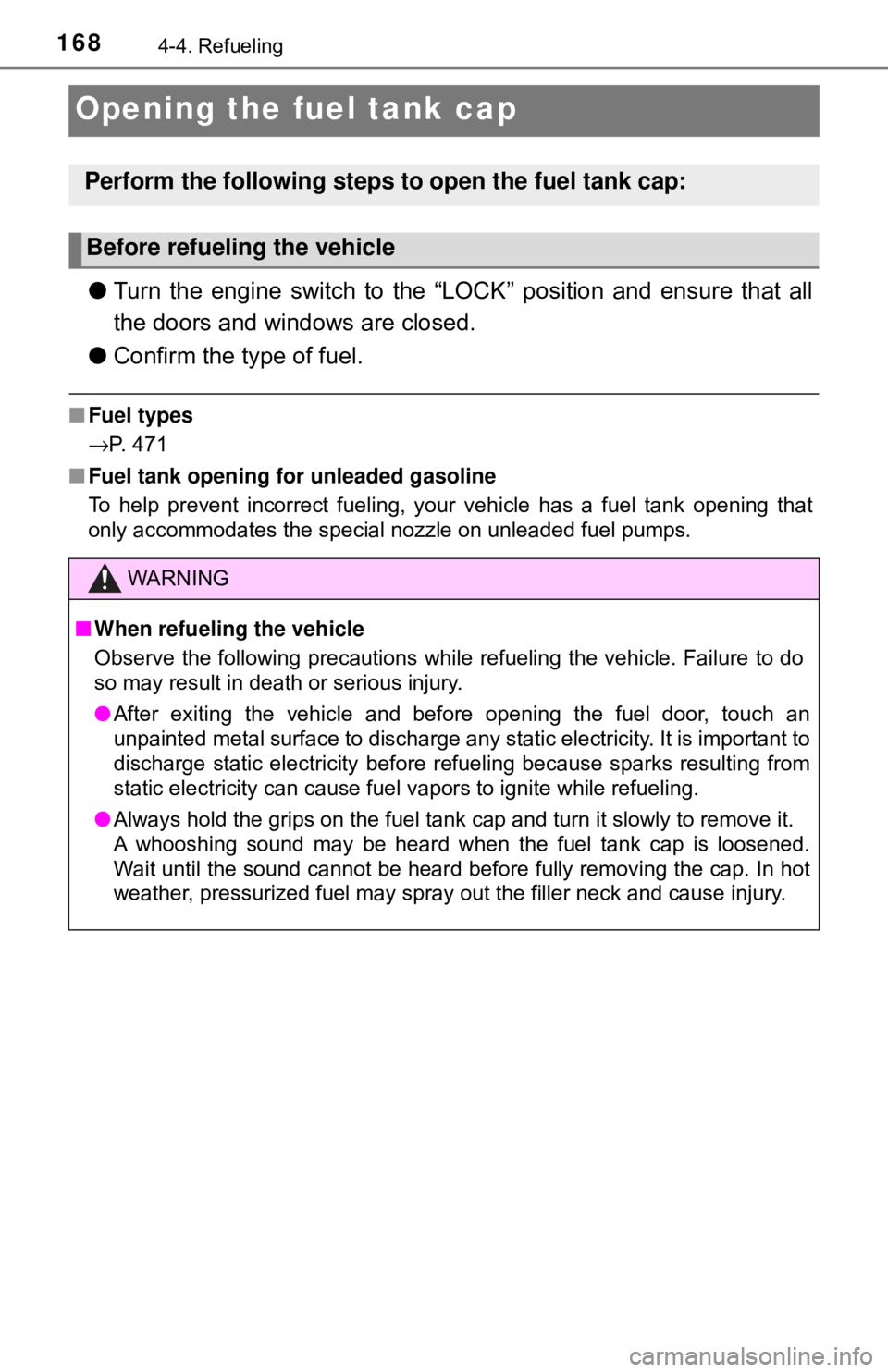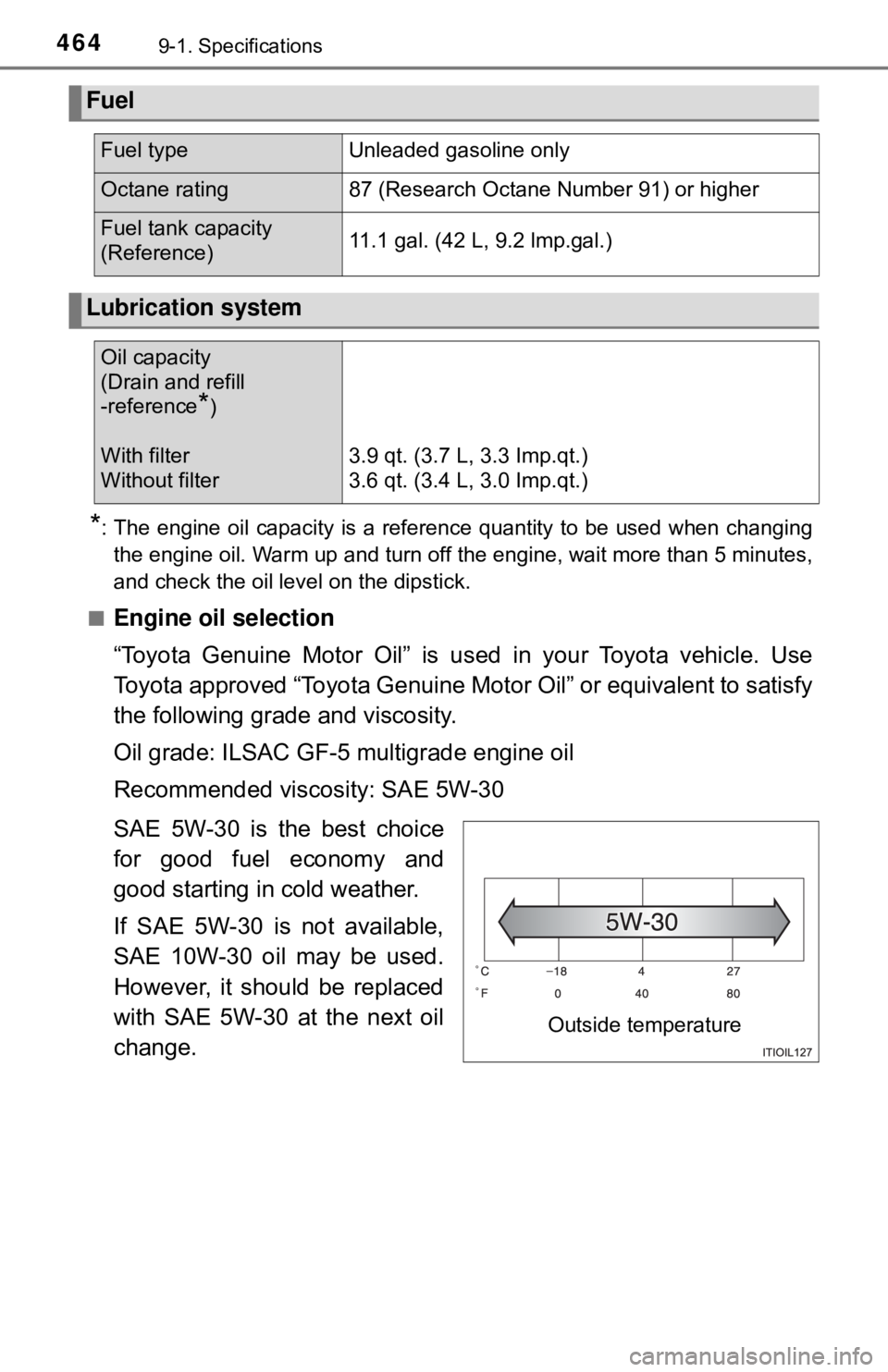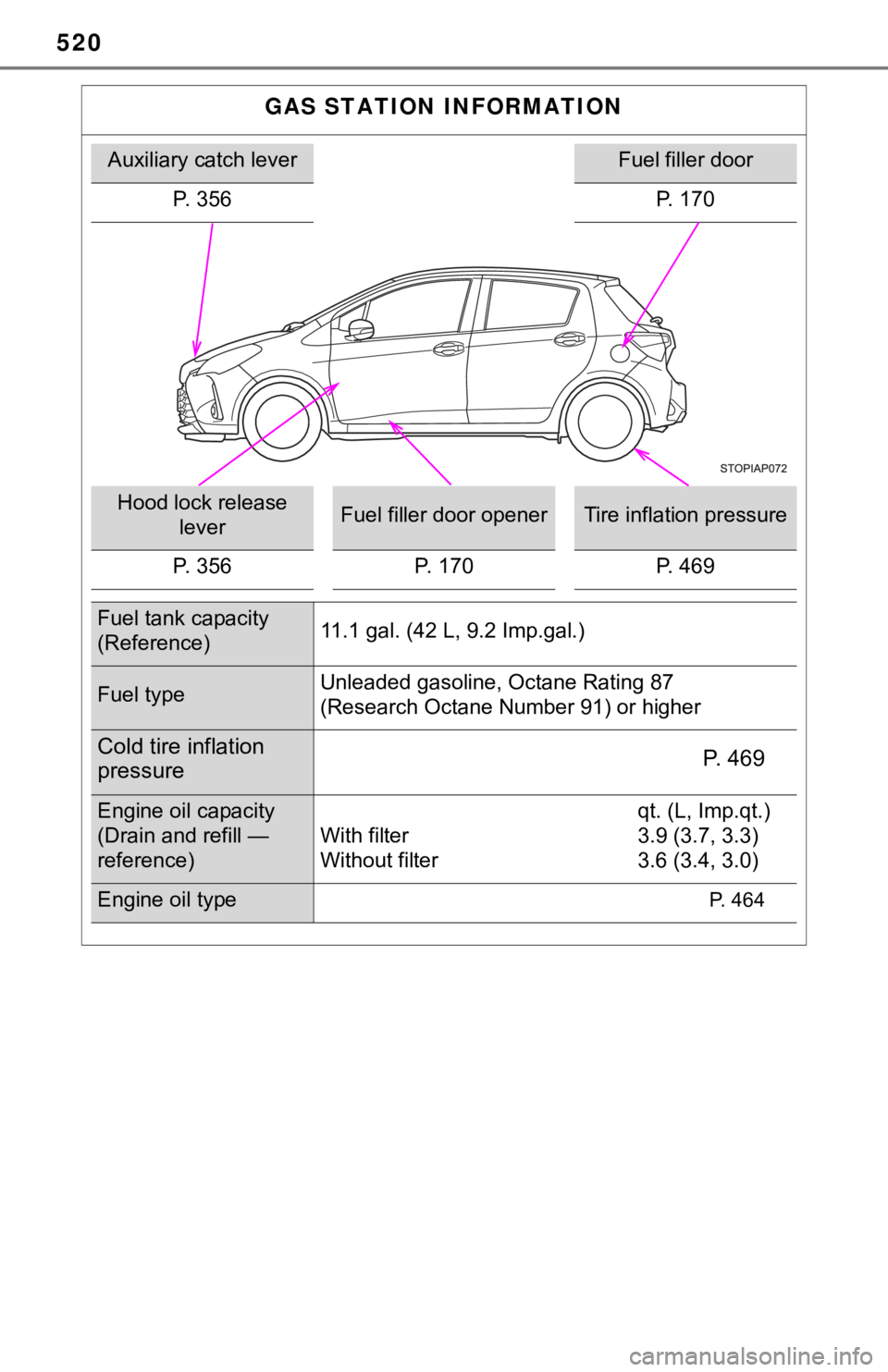2018 TOYOTA YARIS HATCHBACK gas type
[x] Cancel search: gas typePage 44 of 520

441-1. For safe use
■If the SRS airbags deploy (inflate)
●Slight abrasions, burns, bruising, etc., may be sustained from SRS airbags,
due to the extremely high speed deployment (inflation) by hot gases.
● A loud noise and white powder will be emitted.
● Parts of the airbag module (steering wheel hub, airbag cover and inflat\
or) as
well as the front seats, parts of the front and rear pillars, and roof side rails,
may be hot for several minutes. The airbag itself may also be hot.
● The windshield may crack.
■ SRS airbag deployment conditions (SRS front airbags)
●The SRS front airbags will deploy in the event of an impact that exceeds the
set threshold level (the level of force corresponding to an approximately 12 -
18 mph [20 - 30 km/h] frontal collision with a fixed wall that does not move or
deform).
However, this threshold velocity will be considerably higher in the following
situations:
• If the vehicle strikes an object, such as a parked vehicle or sign pole,
which can move or deform on impact
• If the vehicle is involved in an underride collision, such as a collision in which the front of the vehicle “underrides”, or goes under, the bed of a
truck
● Depending on the type of collision, it is possible that only the seat belt pre-
tensioners will activate.
● The SRS front airbags for the front passenger will not activate if there is no
passenger sitting in the front passenger seat. However, the SRS front air-
bags for the front passenger may deploy if luggage is put in the seat, even if
the seat is unoccupied.
● The SRS seat cushion airbags on the front seats will not operate if the occu-
pant is not wearing a seat belt.
■ SRS airbag deployment conditions (S RS side and curtain shield airbags)
● The SRS side and curtain shield airbags will deploy in the event of an
impact that exceeds the set threshold level (the level of force corresponding
to the impact force produced by an approximately 3300 lb. [1500 kg] vehicle
colliding with the vehicle cabin from a direction perpendicular to the vehicle
orientation at an approximate speed of 12 - 18 mph [20 - 30 km/h]).
● The SRS curtain shield airbags will deploy in the event of vehicle rollover.
● The SRS curtain shield airbags may also deploy in the event of a severe
frontal collision.
Page 168 of 520

1684-4. Refueling
Opening the fuel tank cap
●Turn the engine switch to the “LOC K” position and ensure that all
the doors and windows are closed.
● Confirm the type of fuel.
■Fuel types
→P. 471
■ Fuel tank opening for unleaded gasoline
To help prevent incorrect fueling, y our vehicle has a fuel tank opening that
only accommodates the special nozzle on unleaded fuel pumps.
Perform the following steps to open the fuel tank cap:
Before refueling the vehicle
WARNING
■ When refueling the vehicle
Observe the following precautions while refueling the vehicle. Failure to do
so may result in death or serious injury.
● After exiting the vehicle and before opening the fuel door, touch an
unpainted metal surface to discharge any static electricity. It is important to
discharge static electricity before refueling because sparks resulting from
static electricity can cause fuel vapors to ignite while refueling.
● Always hold the grips on the fuel tank cap and turn it slowly to remove it.
A whooshing sound may be heard when the fuel tank cap is loosened.
Wait until the sound cannot be heard before fully removing the cap. In hot
weather, pressurized fuel may spray out the filler neck and cause injury.
Page 346 of 520

3467-1. Maintenance and care
NOTICE
■Cleaning detergents
● Do not use the following types of detergent, as they may discolor the vehi-
cle interior or cause streaks or damage to painted surfaces:
• Non-seat portions: Organic substances such as benzene or gasoline,
alkaline or acidic solutions, dye, and bleach
• Seats: Alkaline or acidic solutions, such as thinner, benzene, and alco-
hol
● Do not use a polish wax or polish cleaner. The instrument panel’s or other
interior part’s painted surface may be damaged.
■ Preventing damage to leather surfaces
Observe the following precautions to avoid damage to and deterioration of
leather surfaces:
● Remove any dust or dirt from leather surfaces immediately.
● Do not expose the vehicle to direct sunlight for extended periods of time.
Park the vehicle in the shade, especially during summer.
● Do not place items made of vinyl, plastic, or containing wax on the uphol-
stery, as they may stick to the leather surface if the vehicle interior heats
up significantly.
■ Water on the floor
Do not wash the vehicle floor with water.
Vehicle systems such as the audio system may be damaged if water comes
into contact with electrical components such as the audio system above or
under the floor of the vehicle. Water may also cause the body to rust.
■ When cleaning the inside of th e windshield (vehicles with Toyota
Safety Sense C)
Be careful not to touch the front sensor ( →P. 173).
If the camera is accidentally scratched or hit, PCS, LDA and Automatic High
Beam may not operate properly or may cause a malfunction.
■ Cleaning the inside of the rear window
● Do not use glass cleaner to clean the rear window, as this may cause
damage to the rear window defogger heater wires. Use a cloth dampened
with lukewarm water to gently wipe the window clean. Wipe the window in
strokes running parallel to the heater wires.
● Be careful not to scratch or damage the heater wires.
Page 464 of 520

4649-1. Specifications
*: The engine oil capacity is a reference quantity to be used when changingthe engine oil. Warm up and turn off the engine, wait more than 5 minutes,
and check the oil level on the dipstick.
■
Engine oil selection
“Toyota Genuine Motor Oil” is us ed in your Toyota vehicle. Use
Toyota approved “Toyota Genuine Motor Oil” or equivalent to satisfy
the following grade and viscosity.
Oil grade: ILSAC GF-5 multigrade engine oil
Recommended viscosity: SAE 5W-30
SAE 5W-30 is the best choice
for good fuel economy and
good starting in cold weather.
If SAE 5W-30 is not available,
SAE 10W-30 oil may be used.
However, it should be replaced
with SAE 5W-30 at the next oil
change.
Fuel
Fuel typeUnleaded gasoline only
Octane rating87 (Research Octane Number 91) or higher
Fuel tank capacity
(Reference)11.1 gal. (42 L, 9.2 lmp.gal.)
Lubrication system
Oil capacity
(Drain and refill
-reference
*)
With filter
Without filter 3.9 qt. (3.7 L, 3.3 Imp.qt.)
3.6 qt. (3.4 L, 3.0 Imp.qt.)
Outside temperature
Page 473 of 520

4739-1. Specifications
9
Vehicle specifications
■Non-recommendation of the use of gasoline containing MMT
Some gasoline contains an octane enhancing additive called MMT (Methylcy-
clopentadienyl Manganese Tricarbonyl).
Toyota does not recommend the use of gasoline that contains MMT. If fuel
containing MMT is used, your emission control system may be adversely
affected.
The malfunction indicator lamp on the instrument cluster may come on. If this
happens, contact your Toyota dealer for service.
■ If your engine knocks
●Consult your Toyota dealer.
● You may occasionally notice light knocking for a short time while accelerat-
ing or driving uphill. This is normal and there is no need for concern.
NOTICE
■Notice on fuel quality
● Do not use improper fuels. If improper fuels are used, the engine will be
damaged.
● Do not use leaded gasoline.
Leaded gasoline can cause damage to your vehicle’s three-way catalytic
converters causing the emission control system to malfunction.
● Do not use gasohol other than the type previously stated.
Other gasohol may cause fuel system damage or vehicle performance
problems.
● Using unleaded gasoline with an octane number or rating lower than the
level previously stated will cause persistent heavy knocking.
At worst, this will lead to engine damage.
■ Fuel-related poor driveability
If poor driveability (poor hot starting, vaporization, engine knocking, etc.) is
encountered after using a different type of fuel, discontinue the use of that
type of fuel.
■ When refueling with gasohol
Take care not to spill gasohol. It can damage your vehicle’s paint.
Page 513 of 520

513Alphabetical index
Flat tire...................................... 433
Floor mats .................................. 24
FluidAutomatic transmission......... 466
Brake .................................... 468
Clutch................................... 467
Washer ................................. 369
Fog lights ................................. 160 Replacing light bulbs............. 401
Switch ................................... 160
Wattage ................................ 470
Front passenger’s seat belt reminder light......... 425
Front seats ............................... 106 Adjustment ............................ 106
Cleaning................................ 344
Correct driving posture ........... 26
Head restraints ..................... 113
Front side marker lights.......... 156
Light switch ........................... 156
Replacing light bulbs............. 401
Wattage ................................ 470
Front turn signal lights ........... 154 Replacing light bulbs............. 400
Turn signal lever ................... 154
Wattage ................................ 470
Fuel Capacity ................................ 464
Fuel gauge .............................. 83
Fuel pump shut off system.... 421
Information ............................ 471
Refueling............................... 168
Type ...................................... 464
Warning light ......................... 425
Fuel consumption information .............................. 89 Fuel consumption
Average fuel consumption ...... 86
Instantaneous fuel consumption ......................... 86
Fuel filler door ......................... 168 Refueling .............................. 168
Fuel pump shut off system..... 421
Fuses ........................................ 391
Gas station information .......... 520
Gauges ....................................... 83
Glove box ................................. 331
Hazard lights
Switch ................................... 412
Head restraints ........................ 113
Headlights ................................ 156 Automatic High Beam ........... 196
Light switch ........................... 156
Replacing light bulbs ............ 397
Wattage ................................ 470
Heaters ..................................... 318 Manual air conditioning
system .......... ...................... 318
Outside rear view mirrors ..... 322
Seat heaters ......................... 326
High mounted stoplight Replacing light bulbs ............ 409
Hood ......................................... 356
Open ..................................... 356
Hooks Retaining hooks (floor mat) .... 24
Horn .......................................... 116
F
G
H
Page 520 of 520

520
GAS STATION INFORMATION
Auxiliary catch leverFuel filler door
P. 356 P. 170
Hood lock release leverFuel filler door openerTire inflation pressure
P. 356 P. 170 P. 469
Fuel tank capacity
(Reference) 11.1 gal. (42 L, 9.2 Imp.gal.)
Fuel typeUnleaded gasoline, Octane Rating 87
(Research Octane Number 91) or higher
Cold tire inflation
pressure
P. 4 6 9
Engine oil capacity
(Drain and refill —
reference)qt. (L, Imp.qt.)
With filter 3.9 (3.7, 3.3)
Without filter 3.6 (3.4, 3.0)
Engine oil typeP. 464